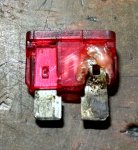I was driving down a dirt road, yesterday, when I noticed the telltale smell of hot plastic. By the time I had the truck stopped, a USB cable plugged into a rechargeable camp light was smoking. Really smoking, like enough to be hazardous with the windows up.
The cable had come completely apart at the connector and was about to catch fire when I unplugged it. :Wow1: I don't know if the cable failed because of vibrations, or was simply faulty. It was a few months old.
So, I'm going to measure the current requirements of all my small stuff (phones, tablets, lights, etc) and replace the fuse on that circuit with a much lower rating. In my rig, that circuit is always hot so my tablet stays charged.
Beware!
A.
The cable had come completely apart at the connector and was about to catch fire when I unplugged it. :Wow1: I don't know if the cable failed because of vibrations, or was simply faulty. It was a few months old.
So, I'm going to measure the current requirements of all my small stuff (phones, tablets, lights, etc) and replace the fuse on that circuit with a much lower rating. In my rig, that circuit is always hot so my tablet stays charged.
Beware!
A.


